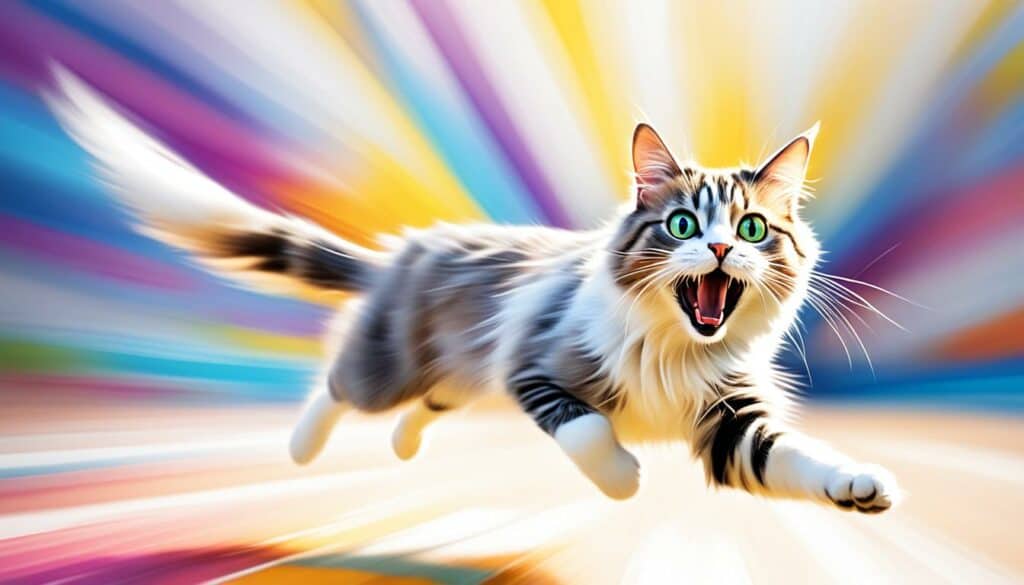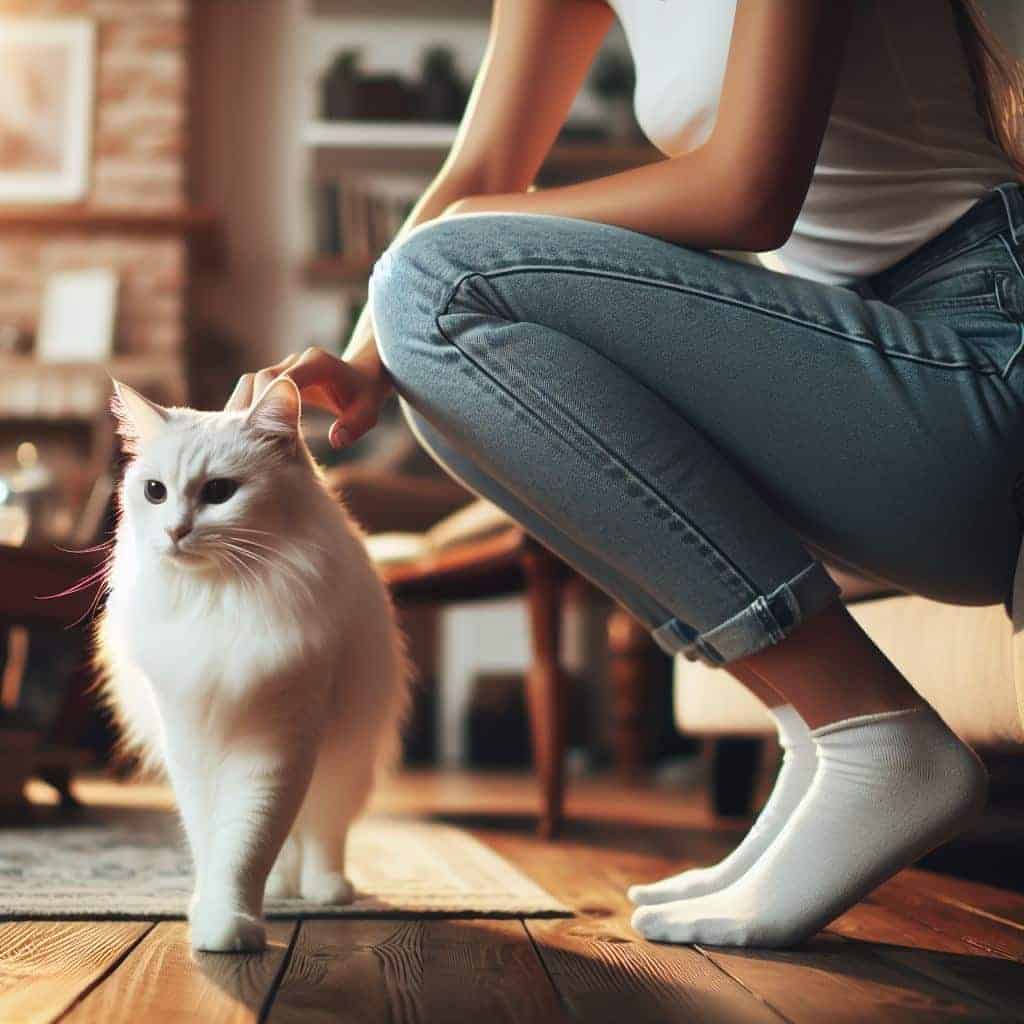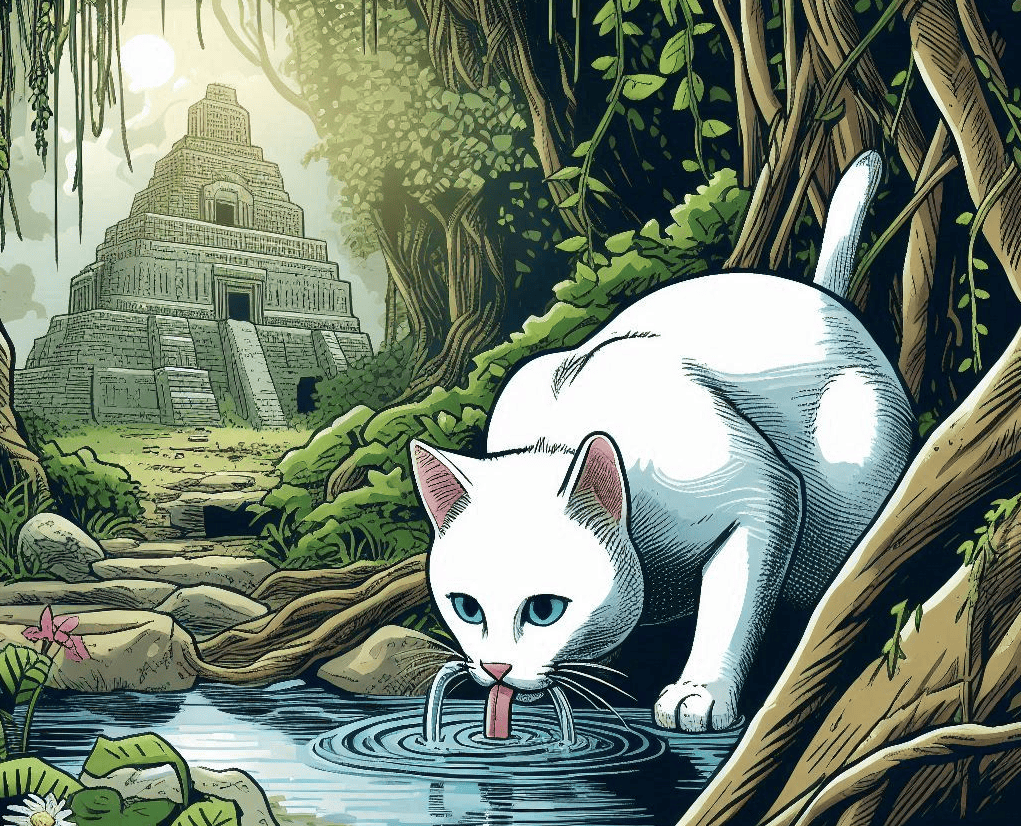
Have you ever caught your feline friend pawing at a dripping faucet or trying to drink from a running tap? You’re not alone! This peculiar behavior has puzzled cat owners for generations. As it turns out, our whiskered companions have a fascinating affinity for running water that goes beyond mere curiosity.
Imagine this ➡️ You’ve just filled your cat’s water bowl with fresh, clean water. Yet, there she sits, meowing incessantly at the kitchen sink. What gives? Well, according to a study published in the Journal of Veterinary Behavior, cats have a natural preference for running water over still water.
This instinctual behavior is rooted in their evolutionary past, where running water sources were typically safer and fresher than stagnant pools.
Many cat owners report that their feline companions are more likely to drink from a flowing water source, such as a cat water fountain, compared to a traditional bowl[1][2].
But why do our feline friends prefer their H2O on the move? In this post, we shall go deep into 5 reasons regarding their love affair with moving water. 💦 From whisker sensitivity to wild instincts, we’ll uncover the reasons behind this behavior and share some tips to keep your feline hydrated and happy.
Reason #1: The Natural Instinct: Cats and Water in the Wild
Evolutionary Traits of Wildcats
Wildcats, the ancestors of our domestic feline friends, have shaped the water preferences we see in our pets today. These ancient hunters evolved in diverse environments, from arid deserts to lush forests. Their survival often depended on finding fresh, moving water sources.
In the wild, still water can harbor bacteria, parasites, and other nasties that might make a cat sick. Running water, on the other hand, is often cleaner and safer to drink. This instinctive preference for moving water has been passed down to our domestic cats, explaining why your kitty might turn her nose up at a perfectly good water bowl. Interestingly, not all wildcats avoid still water. Some species, like tigers and jaguars, are excellent swimmers and will readily plunge into lakes or rivers.
However, most small wildcats prefer to keep their paws dry, a trait that’s definitely carried over to our house cats. 😼
Hunting and Survival Instincts
A cat’s fascination with running water goes beyond just drinking. It’s tied deeply to their hunting instincts. In the wild, moving water often means live prey – fish darting through streams or insects skimming the surface.
This connection explains why many cats paw at water streams or try to “catch” the water flowing from a faucet. They’re not just playing; they’re instinctively trying to hunt! This behavior, known as “fishing,” is seen in both wild and domestic cats.
Moreover, the ability to find clean, running water is a crucial survival skill for wildcats. Those who could locate and remember the positions of fresh water sources had a better chance of survival and passing on their genes. Your domestic cat’s interest in your bathroom sink might just be an echo of this ancient survival tactic!
Wildcat Species |
Water Behavior |
Natural Habitat |
|---|---|---|
| Tiger | Enjoys swimming, often bathes | Forests, grasslands |
| Leopard Cat | Fishes in shallow streams | Tropical forests |
| Sand Cat | Rarely drinks, gets moisture from prey | Deserts |
| Fishing Cat | Specializes in catching fish | Wetlands, mangroves |
| Ocelot | Comfortable around water, good swimmer | Tropical forests |
The table above showcases the diverse water-related behaviors of different wildcat species, highlighting how habitat influences their relationship with water. It’s a fascinating glimpse into the ancestral roots of our domestic cats’ water preferences!
Remember, your kitty’s quirky water habits aren’t just random – they’re the result of millions of years of feline evolution. Next time you see your cat pawing at a water stream, you’re witnessing an ancient instinct in action. Pretty cool, right?
Reason #2: The Appeal of Movement: Why Running Water Attracts Cats
Visual Stimulation
Cats are visual hunters, and moving water captures their attention like few other things can. The ripples, splashes, and reflections create a constantly changing visual display that’s irresistible to feline eyes. This attraction isn’t just about aesthetics – it’s deeply rooted in their hunting instincts.
In the wild, movement often signals the presence of prey. A fish’s fin breaking the surface, or an insect skimming across a stream, triggers a cat’s predatory response. Your domestic cat’s fascination with the kitchen faucet or a dripping tap taps into this same instinct. They’re not just watching – they’re on the hunt!
Interestingly, a cat’s ability to perceive motion is far superior to their ability to see stationary objects. Their eyes are specially adapted to detect even the slightest movements. This explains why your cat might ignore their still water bowl but come running at the sound of the tap. The moving water represents a more “alive” and therefore more interesting target for their keen senses.
Sound Attraction
The sound of running water is another powerful attraction for cats. In nature, the gurgle of a stream or the pattern of raindrops can guide cats to freshwater sources. This auditory cue is so ingrained that many cats will respond to the sound of running water even if they can’t see it.
The appeal goes beyond just finding water to drink. The sound of moving water can trigger a cat’s curiosity and playful instincts. It’s not uncommon to see a cat batting at a stream of water or trying to “catch” the sound with their paws. This behavior mimics how they might interact with small, fast-moving prey in the wild.
Moreover, the sound of running water can have a calming effect on some cats. You might notice your cat seems more relaxed or content when near a running faucet or a pet water fountain. This soothing effect might be linked to positive associations with fresh water sources in their ancestral environments.
Curiosity and Play Instinct
Cats are naturally curious creatures, and running water presents an ever-changing puzzle for them to explore. The unpredictable nature of water movement – each droplet falling in a slightly different way – keeps cats engaged and interested. This curiosity is a key survival trait that encourages cats to investigate and learn about their environment.
Play is another crucial aspect of feline behavior, and water often becomes a favorite toy. When a cat paws at a stream of water, they’re not just having fun – they’re honing their hunting skills. The quick reflexes required to catch a water droplet are the same ones needed to snag a speedy mouse or bird.
The table below offers a quick reference for common water-related behaviors in cats, their possible interpretations, and how they relate to behaviors observed in wild cats. It’s a handy guide for understanding why your domestic cat might be so fascinated by that dripping faucet!
Cat Behavior |
Possible Interpretation |
Related Wild Behavior |
|---|---|---|
| Pawing at running water | Hunting instinct, play | Fishing for prey in streams |
| Drinking from a moving stream | Preference for fresh water | Seeking clean water sources |
| Watching water intently | Visual hunting, curiosity | Spotting movement of potential prey |
| Responding to water sounds | Auditory hunting cues | Locating water sources by sound |
| Playing in or around water | Skill development, enrichment | Learning to navigate watery environments |
Your cat’s interest in running water isn’t just a quirk – it’s a window into their wild heritage. Every time they interact with moving water, they’re expressing deeply ingrained instincts that have helped cats survive and thrive for millions of years. So the next time you ask, “Why do cats like running water?”, you’ll know it’s all part of being a cat!
Reason #3: Freshness Factor: Why Cats Prefer Running Water to Still Water
Oxygenation and Taste
Cats have an incredibly refined sense of taste, far more sensitive than humans. Running water contains more dissolved oxygen than still water, which significantly improves its taste. This oxygenation makes the water feel fresher and more appealing to your feline friend.
In the wild, moving water sources like streams and rivers constantly replenish their oxygen content through turbulence and interaction with the air. This process not only keeps the water tasting fresh but also helps to disperse any accumulated minerals or organic matter that might affect the flavor. Your cat’s preference for running water from the tap or a fountain mimics this natural preference for well-oxygenated water.
Did you know some cats will go to great lengths to find oxygenated water? You might notice your cat dipping their paw into their water bowl and licking the droplets off. This behavior isn’t just playful – it’s a clever way to aerate the water and improve its taste.
By understanding this preference, we can see why many cats turn their noses up at day-old water in a bowl, even if it looks clean to us.
Perceived Cleanliness
Cats are naturally cautious about their water sources, an instinct that has served them well throughout evolution. In the wild, stagnant water can harbor harmful bacteria, parasites, and other contaminants. Running water, on the other hand, is often cleaner due to constant movement and filtration.
Your domestic cat retains this instinctive preference for “clean” water. When they see water moving, whether it’s from a tap, a fountain, or even raindrops on a window, they perceive it as fresh and safe to drink. This perception can lead cats to seek out running water sources even when clean, still water is readily available. Moreover, cats have an acute sense of smell that plays a role in their water preferences. Standing water can accumulate odors over time, especially if the bowl is placed near their food or litter box. These smells might be imperceptible to us but can be off-putting to a cat’s sensitive nose. Running water, with its constant renewal, avoids this problem and remains appealing to your cat’s discerning senses.
Temperature Preferences
The temperature of water plays a crucial role in a cat’s drinking preferences. Running water often feels cooler than standing water, which can make it more appealing. In nature, cool, running water is typically fresher and safer to drink than warm, stagnant water.
Cats have evolved to prefer water that’s slightly cool, around 15-20°C (59-68°F). This temperature range is often found in natural, moving water sources. When water stands still, it tends to warm up to room temperature, which might not be as refreshing or enticing to your feline friend.
Factor |
Running Water |
Still Water |
Cat’s Preference |
|---|---|---|---|
| Oxygenation | High | Low | Prefers high oxygenation |
| Perceived Cleanliness | High | Variable | Prefers perceived cleanliness of running water |
| Temperature | Typically cooler | Tends to warm up | Prefers cooler temperatures |
| Odor Accumulation | Low | Potentially high | Prefers low odor |
| Visual Appeal | High (movement) | Low | Attracted to movement |
| Taste | Fresh, crisp | Can become stale | Prefers fresh taste |
Here’s a quick comparison table between running and still water, highlighting why cats often prefer running water. It’s a handy reference for understanding your cat’s water preferences!
Understanding these preferences can help you ensure your cat stays well-hydrated. Whether you opt for a cat fountain, regularly change their water, or let them drink from a running tap under supervision, catering to their natural inclinations can lead to a happier, healthier cat. Remember, when it comes to cats and water, fresh and moving is always in fashion!
Reason #4: The Whisker Factor: How Cat Anatomy Influences Water Preferences
Whisker Sensitivity
Cat whiskers are marvels of evolutionary design. These specialized hairs, also known as vibrissae, serve as highly sensitive touch receptors. Each whisker connects to a follicle packed with nerves, allowing cats to detect the slightest changes in their environment. When it comes to water, this sensitivity plays a crucial role in your cat’s preferences and behaviors. When a cat approaches a water bowl, their whiskers can brush against the sides, causing discomfort or overstimulation.
This phenomenon, known as “whisker fatigue,” can make drinking from narrow or deep bowls an unpleasant experience. Running water, on the other hand, allows cats to drink without their whiskers touching the sides of a container, making it a more comfortable option.
Cats’ whiskers don’t just detect touch – they’re also sensitive to air currents and vibrations. The movement of running water creates subtle air disturbances that cats can detect with their whiskers. This ability helps them locate water sources in the wild and contributes to their fascination with moving water in domestic settings. It’s like having a built-in water detection system!
Bowl Shape and Size Considerations
The shape and size of a water bowl can significantly impact a cat’s drinking experience. Cats generally prefer wide, shallow bowls that allow them to drink without their whiskers touching the sides. This preference stems from their natural drinking posture – in the wild, cats often drink from wide bodies of water like streams or ponds.
Deep or narrow bowls can cause whisker stress, leading to what some cat owners might perceive as fussy behavior. If your cat paws at their water, tips the bowl over, or seems reluctant to drink, the bowl itself might be the culprit. Opting for a wider, shallower bowl can make a world of difference in your cat’s comfort and willingness to drink. It’s worth noting that some cats prefer to drink from unconventional sources like cups, sinks, or even plant saucers.
This behavior often relates to the shape of these containers – they offer a wide surface area that doesn’t interfere with whiskers. While it’s important to provide a proper water bowl, understanding these preferences can help you ensure your cat stays well-hydrated.
Comfort While Drinking
A cat’s unique anatomy influences their drinking technique. Unlike dogs, who lap up water with their tongues curled backwards, cats use the tip of their tongue to quickly touch the water surface, creating a column of water that they then snap shut their jaws around. This high-speed maneuver happens faster than the human eye can follow – up to four times per second!
This drinking method requires a certain level of comfort and stability. Running water provides an ideal scenario for this technique. The constant flow allows cats to drink from the stream itself, avoiding any need to lower their head into a bowl. This position feels more natural and secure, as it mimics drinking from a flowing water source in the wild. Moreover, the sound and movement of running water can stimulate a cat’s interest and encourage more frequent drinking.
Many cats will spend more time interacting with a flowing water source, leading to increased hydration. This is particularly beneficial for cats prone to urinary tract issues, where increased water intake can help maintain urinary health.
Factor |
Impact on Cat Drinking Behavior |
Ideal Solution |
|---|---|---|
| Whisker Sensitivity | Can cause discomfort with narrow bowls | Wide, shallow bowls or running water sources |
| Bowl Shape | Affects whisker comfort and drinking posture | Shallow, wide bowls or cat fountains |
| Bowl Size | Too small can cause whisker stress | Large enough to fit cat’s face without whisker contact |
| Water Movement | Attracts cats, mimics natural sources | Cat fountains or supervised tap water access |
| Drinking Technique | Requires space for proper tongue movement | Open water surfaces or gentle water flow |
| Posture Comfort | Affects willingness to drink | Elevated bowls or sources that don’t require lowering the head |
The table above showcases how various factors related to cat anatomy influence their water preferences and drinking behavior. It’s a handy guide for cat owners looking to optimize their pet’s hydration experience!
Understanding these anatomical factors can help you create the perfect drinking setup for your feline friend. Whether you choose a wide, shallow bowl, a cat fountain, or allow supervised access to a gently running tap, catering to your cat’s natural preferences can encourage better hydration habits. Remember, when it comes to cats and water, comfort is key!
Reason #5: Behavioral Aspects: Psychological Reasons Behind the Preference
Learned Behaviors
Cats are creatures of habit, and their preferences for running water often stem from learned behaviors. These behaviors can start as early as kittenhood. If a kitten observes its mother drinking from a faucet or playing with running water, it’s likely to mimic this behavior. This early imprinting can create a lifelong preference for moving water sources.
Moreover, cats quickly learn to associate certain behaviors with positive outcomes. If a cat discovers that pawing at a faucet results in a stream of fresh water, they’ll likely repeat this behavior. This kind of operant conditioning can be so strong that some cats learn to turn on taps by themselves!
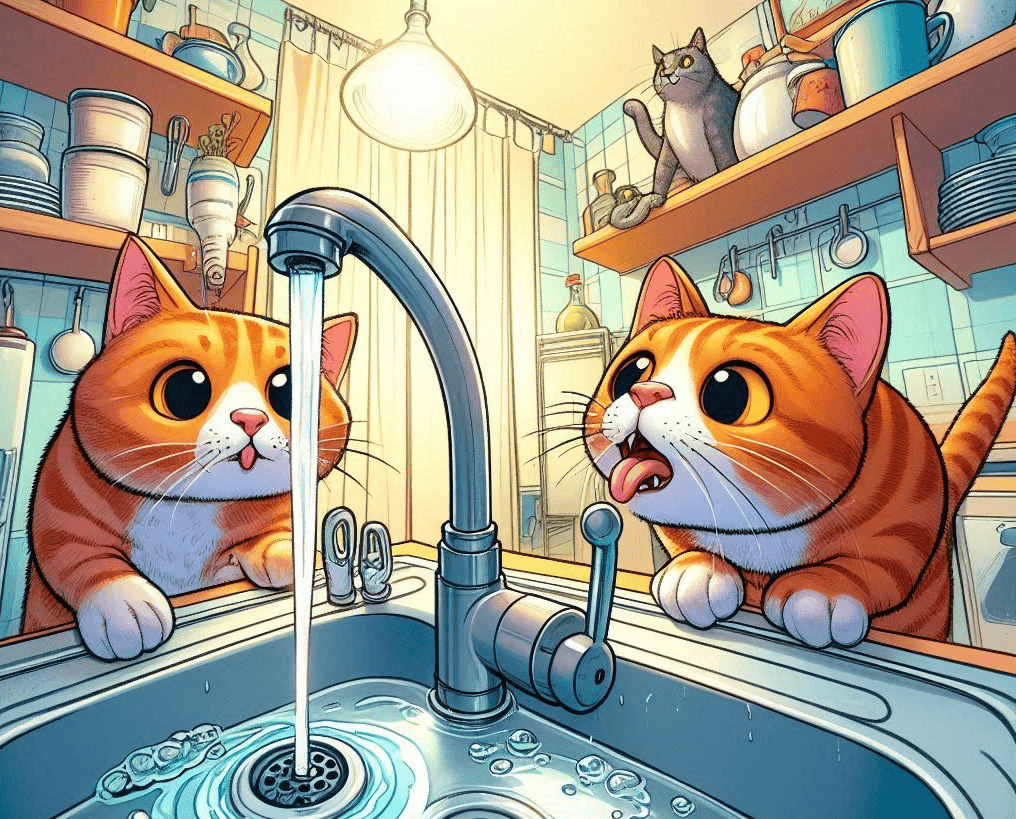
Attention-Seeking Behavior
Sometimes, a cat’s fascination with running water isn’t just about the water itself – it’s about you! Cats are clever creatures and quickly learn that certain behaviors get their human’s attention. If your cat has noticed that playing with the faucet or begging for the tap to be turned on gets you to interact with them, they might repeat this behavior for the attention alone.
This attention-seeking aspect can be particularly pronounced in cats who are bored or under-stimulated. The act of asking for running water becomes a form of entertainment and engagement. It’s not uncommon for cats to develop a “routine” around faucets or fountains, expecting their humans to participate at certain times of day. It’s worth noting that while this behavior can be cute, it’s important not to reinforce it unintentionally if it becomes problematic.
Instead, redirect your cat’s attention to more appropriate water sources like pet fountains, and ensure they have plenty of other stimulating activities throughout the day.
Stress Relief and Comfort
For many cats, running water provides more than just hydration – it offers a form of stress relief and comfort. The sound of trickling water can have a calming effect, similar to how some humans find the sound of rain or ocean waves soothing. This auditory stimulation can help reduce anxiety and promote relaxation in cats. Additionally, the act of playing with or drinking from running water can serve as a form of environmental enrichment.
It engages multiple senses – touch, sight, sound, and taste – providing a stimulating and enjoyable experience. For indoor cats especially, this multi-sensory engagement can be a valuable source of mental and physical stimulation.
Some cats may also associate running water with positive experiences or comfort. For example, if a cat has been given treats or affection while drinking from a faucet, they may seek out this experience as a form of comfort when feeling stressed or anxious. This behavior underscores the complex emotional lives of cats and how their preferences can be shaped by psychological factors.
Understanding these psychological factors can help you create a more enriching environment for your feline friend. Whether it’s providing a cat fountain, engaging in supervised water play, or simply being mindful of your cat’s water preferences, acknowledging these behavioral aspects can lead to a happier, healthier cat. Remember, every cat is unique – what works for one might not work for another, so observation and patience are key in understanding your own cat’s psychological needs around water.
Common Household Water Sources That Attract Cats
Faucets and Sinks
Faucets and sinks rank among the top water sources that fascinate cats. The allure lies in the combination of running water, the sound it makes, and the novelty of the experience. Many cats will sit patiently by the sink, waiting for their human to turn on the tap. Some even learn to paw at the faucet, hoping to trigger a stream of water themselves!
The height of the faucet plays a role in its appeal. Cats often prefer to drink with their heads up, as this position feels more natural and secure. It mimics drinking from elevated water sources in the wild, where they can keep an eye on their surroundings. The steady stream from a faucet provides this ideal drinking posture. Interestingly, different cats show preferences for different types of faucets. Some like a full stream of water, while others prefer a gentle trickle.
The temperature can also matter – many cats enjoy cool water, but some develop a taste for warm water from the hot tap. Pay attention to your cat’s preferences; they might surprise you with their specificity!
Showers and Bathtubs
While we often think of cats as water-averse, many felines find showers and bathtubs irresistible. The large, smooth surface of a bathtub can be enticing, especially when small puddles form. Some cats enjoy licking water droplets off the tub’s surface or catching drips from the showerhead.
The fascination with showers often extends beyond just the water. Many cats are drawn to the bathroom routine, following their humans and showing curiosity about this daily ritual. Some brave kitties even venture into the shower while it’s running, batting at water droplets or playing in small streams running down the walls. For safety, always supervise your cat around showers and bathtubs. While most cats will avoid getting completely wet, accidents can happen.
Additionally, be cautious about leaving standing water in the tub, as this can be a drowning hazard for small animals.
Toilet Bowls (and Why to Discourage This)
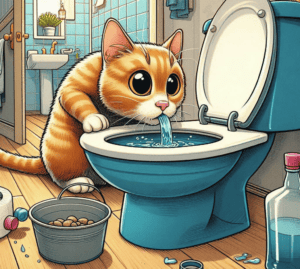 Despite our best efforts, some cats find toilet bowls an appealing water source. The constantly available water and the unique shape of the bowl can attract curious felines.
Despite our best efforts, some cats find toilet bowls an appealing water source. The constantly available water and the unique shape of the bowl can attract curious felines.
Some cats even learn to flush the toilet to get fresh water – a trick that’s both impressive and potentially problematic! However, it’s crucial to discourage this behavior. Toilet water can contain harmful bacteria and chemicals, especially if you use bowl cleaners or automatic dispensers.
Additionally, there’s a risk of cats ingesting trace amounts of human waste, which can lead to health issues.
To deter your cat from drinking from the toilet, always keep the lid closed. Provide alternative, more appealing water sources like cat fountains or clean, wide bowls. If your cat persists, consider using childproof toilet locks until the habit is broken.
Understanding your cat’s attraction to various water sources can help you create a safer, more cat-friendly home environment. By providing appropriate alternatives and managing access to less desirable water sources, you can ensure your feline friend stays hydrated in a safe and enjoyable way. Remember, every cat is unique – what attracts one might not interest another, so observation and patience are key in catering to your cat’s individual preferences.
Potential Risks and Precautions
Water Safety in the Home
While cats’ fascination with running water can be endearing, it’s crucial to ensure their safety around household water sources. Open toilets, full bathtubs, and even large buckets can pose drowning risks, especially for curious kittens or elderly cats with limited mobility. Always keep toilet lids closed and drain bathtubs immediately after use.
Sinks and countertops present another set of challenges. Cats may slip on wet surfaces or knock over fragile items while pursuing water. Consider placing non-slip mats near frequently used water sources and keep breakable items away from areas where your cat likes to explore. Electrical hazards also warrant attention. Cats pawing at faucets or playing in sinks might come into contact with nearby electrical appliances. Ensure all bathroom and kitchen electronics are safely stored and use ground fault circuit interrupters (GFCIs) in outlets near water sources to prevent potential shocks.
Avoiding Contaminated Water Sources
Cats’ attraction to unusual water sources can lead them to drink from potentially contaminated areas. Stagnant outdoor puddles, birdbaths, and even fish tanks can harbor harmful bacteria, parasites, or chemicals. Discourage your cat from accessing these sources by providing fresh, clean water indoors and supervising outdoor time. Indoor plants and vases can also tempt thirsty cats. However, the water in these containers often contains fertilizers, bacteria, or even toxic plant residues. Keep plants out of reach or use plant stakes to prevent access to the soil and water.
Chemical treatments in swimming pools and hot tubs pose serious health risks to cats. While some cats may be attracted to these large bodies of water, ingestion of pool chemicals can cause severe gastrointestinal issues or chemical burns. Always cover pools and hot tubs when not in use and never allow your cat unsupervised access to these areas.
Monitoring Water Intake
While encouraging hydration is important, excessive water consumption can signal underlying health issues. Conditions like diabetes, kidney disease, or hyperthyroidism may cause increased thirst. If you notice your cat drinking significantly more than usual, consult with a veterinarian to rule out potential health problems.
On the flip side, some cats may not drink enough, especially if they dislike their water source. Chronic dehydration can lead to urinary tract issues and other health complications. Monitor your cat’s water intake and urine output. Look for signs of dehydration such as lethargy, dry gums, or decreased skin elasticity. Consider tracking your cat’s water consumption by measuring the amount you put in their bowl and what remains after 24 hours. This information can be valuable for your vet if health concerns arise.
Remember, cats on wet food diets naturally drink less water, as they get much of their hydration from their food. The table below summarizes potential risks associated with cats’ water-seeking behaviors and provides strategies to mitigate these risks.
Risk Factor |
Potential Consequences |
Prevention Strategies |
|---|---|---|
| Open water sources | Drowning, especially for kittens/elderly cats | Keep toilet lids closed, drain tubs promptly |
| Wet surfaces | Slips, falls, broken items | Use non-slip mats, clear counters near sinks |
| Electrical hazards | Shocks from nearby appliances | Use GFCIs, keep electronics away from water |
| Contaminated outdoor water | Bacterial/parasitic infections | Provide clean indoor water, supervise outdoors |
| Plant water/vases | Ingestion of toxins or bacteria | Keep plants out of reach, use plant stakes |
| Pool/hot tub chemicals | Chemical burns, gastrointestinal issues | Cover when not in use, restrict access |
| Excessive drinking | May indicate underlying health issues | Monitor intake, consult vet if concerned |
| Inadequate water intake | Dehydration, urinary tract problems | Provide appealing water sources, track consumption |
Cats have a remarkably efficient kidney system that allows them to conserve water and tolerate fairly low water intake. This evolutionary trait stems from their desert-dwelling ancestors. However, domestic cats still benefit from encouraging proper hydration to support overall health and prevent urinary issues. By understanding these potential risks and taking appropriate precautions, you can create a safer environment for your water-loving feline. Each cat has unique preferences and behaviors, so observation and adaptability are key. With the right approach, you can satisfy your cat’s fascination with water while ensuring their safety and well-being.
Summing Up
Remember, every cat is unique. While many cats share a love for running water, others might be perfectly content with a still bowl. The key is to observe your cat’s preferences and behaviors, then adapt accordingly. By doing so, you’re not just solving the mystery of why cats like running water – you’re strengthening your bond with your feline companion and ensuring they lead a happier, healthier life.
So the next time you see your cat pawing at the faucet or mesmerized by a dripping tap, take a moment to appreciate the complex creature before you. That simple fascination with running water is a window into their wild heritage, their keen senses, and their individual personality. It’s just one of the many things that make cats such intriguing and beloved companions.

In her previous life, Lisa traveled extensively, both for work and leisure. After the pandemic struck, Lisa locked up her luggage and adopted a cat ever since.
Lisa is now an avid cat lover, she devotes most of her free time serving as butler to her adorable feline at home. When she is not with her cat, she can be seen using her phone sourcing for the latest cat supplies online.

